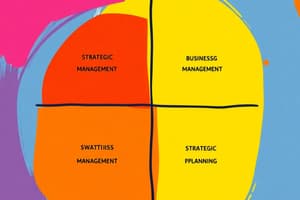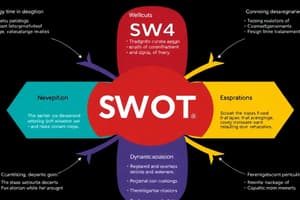Podcast
Questions and Answers
What is the primary purpose of conducting a SWOT analysis?
What is the primary purpose of conducting a SWOT analysis?
- To assess employee satisfaction levels
- To analyze the technological advancements in the industry
- To determine strengths, weaknesses, opportunities, and threats (correct)
- To identify the financial performance of an organization
Which of the following is NOT a component of the external assessment in a SWOT analysis?
Which of the following is NOT a component of the external assessment in a SWOT analysis?
- PESTLE
- Opportunities
- Threats
- Strengths (correct)
Which factor is considered under PESTLE analysis?
Which factor is considered under PESTLE analysis?
- Company culture
- Political conditions (correct)
- Market segmentation
- Resource allocation
What does the bargaining power of buyers refer to in Porter’s Five Forces?
What does the bargaining power of buyers refer to in Porter’s Five Forces?
Which of the following best describes the 'Threat of new entrants' in Porter’s Five Forces?
Which of the following best describes the 'Threat of new entrants' in Porter’s Five Forces?
Why is it beneficial to view management and leadership as skills rather than roles or titles?
Why is it beneficial to view management and leadership as skills rather than roles or titles?
What has contributed to the shift in a manager's role from directing to leading?
What has contributed to the shift in a manager's role from directing to leading?
What is one of the four functions of management?
What is one of the four functions of management?
What is a significant factor in why employees leave managers more often than companies?
What is a significant factor in why employees leave managers more often than companies?
What is a critical activity of a manager during the planning function?
What is a critical activity of a manager during the planning function?
Which of these statements aligns with the evolving role of managers?
Which of these statements aligns with the evolving role of managers?
What makes the role of a manager particularly challenging in today's global organizations?
What makes the role of a manager particularly challenging in today's global organizations?
Which skill is considered one of the top three skills of an effective manager?
Which skill is considered one of the top three skills of an effective manager?
What is the primary focus of the content presented?
What is the primary focus of the content presented?
Which of the following best describes the tone of the content?
Which of the following best describes the tone of the content?
In the context provided, which aspect is least likely to be discussed?
In the context provided, which aspect is least likely to be discussed?
What type of content structure is utilized?
What type of content structure is utilized?
Which of the following statements is most supported by the underlying theme?
Which of the following statements is most supported by the underlying theme?
What is primarily the focus of establishing goals in a business?
What is primarily the focus of establishing goals in a business?
What does SMART in SMART Goals primarily help with?
What does SMART in SMART Goals primarily help with?
Which of the following best describes the purpose of organizing in management?
Which of the following best describes the purpose of organizing in management?
What is a primary outcome of effective organizational design?
What is a primary outcome of effective organizational design?
Which statement correctly describes the relationship between goals and objectives?
Which statement correctly describes the relationship between goals and objectives?
Which skill is less utilized by top managers compared to supervisory managers?
Which skill is less utilized by top managers compared to supervisory managers?
What is a key difference between management skills and leadership skills?
What is a key difference between management skills and leadership skills?
Which of the following is NOT considered a leading skill?
Which of the following is NOT considered a leading skill?
What does Maslow’s Hierarchy of Needs primarily relate to in a management context?
What does Maslow’s Hierarchy of Needs primarily relate to in a management context?
Which leadership aspect involves guiding people toward a shared goal?
Which leadership aspect involves guiding people toward a shared goal?
Which management function primarily involves fostering the organization's stability?
Which management function primarily involves fostering the organization's stability?
How do management skills and leadership skills differ in their approach to change?
How do management skills and leadership skills differ in their approach to change?
Which aspect is essential for maximizing the efforts of others in an organization?
Which aspect is essential for maximizing the efforts of others in an organization?
What is one advantage of the democratic style of leadership?
What is one advantage of the democratic style of leadership?
What trait is commonly found in effective managers?
What trait is commonly found in effective managers?
Which of the following is NOT a key aspect of the controlling function in management?
Which of the following is NOT a key aspect of the controlling function in management?
What is the first step Nick should take to set up a formal control system for his company?
What is the first step Nick should take to set up a formal control system for his company?
In the context of controlling, what is meant by 'providing feedback'?
In the context of controlling, what is meant by 'providing feedback'?
Why might a manager choose to implement a balanced scorecard?
Why might a manager choose to implement a balanced scorecard?
What corrective action should a manager take when performance standards are not met?
What corrective action should a manager take when performance standards are not met?
What role does establishing clear standards play in the controlling function of management?
What role does establishing clear standards play in the controlling function of management?
Flashcards
SWOT Analysis
SWOT Analysis
A strategic planning method used to identify internal strengths and weaknesses, and external opportunities and threats for a business or organization.
Internal Assessment
Internal Assessment
Evaluating a company's resources, capabilities, and structure.
External Assessment
External Assessment
Analyzing factors outside the company, such as the market, competition, and regulations.
PESTLE Analysis
PESTLE Analysis
Signup and view all the flashcards
Porter's Five Forces
Porter's Five Forces
Signup and view all the flashcards
Manager's Evolving Role
Manager's Evolving Role
Signup and view all the flashcards
Manager's Core Responsibility
Manager's Core Responsibility
Signup and view all the flashcards
Manager's Authority
Manager's Authority
Signup and view all the flashcards
Management Skills Shift
Management Skills Shift
Signup and view all the flashcards
Importance of Employee Success
Importance of Employee Success
Signup and view all the flashcards
Manager-Employee Retention
Manager-Employee Retention
Signup and view all the flashcards
Four Functions of Management
Four Functions of Management
Signup and view all the flashcards
Top 3 Management Skills
Top 3 Management Skills
Signup and view all the flashcards
Planning Goals
Planning Goals
Signup and view all the flashcards
Planning Objectives
Planning Objectives
Signup and view all the flashcards
SMART goals
SMART goals
Signup and view all the flashcards
Organizational design
Organizational design
Signup and view all the flashcards
Organizing
Organizing
Signup and view all the flashcards
Manager's new role
Manager's new role
Signup and view all the flashcards
Manager's key responsibility
Manager's key responsibility
Signup and view all the flashcards
Employee success focus
Employee success focus
Signup and view all the flashcards
Manager-employee retention link
Manager-employee retention link
Signup and view all the flashcards
Technical Skills
Technical Skills
Signup and view all the flashcards
Conceptual Skills
Conceptual Skills
Signup and view all the flashcards
Human Relations Skills
Human Relations Skills
Signup and view all the flashcards
Leading: Guiding People
Leading: Guiding People
Signup and view all the flashcards
Leading: Maximizing Efforts
Leading: Maximizing Efforts
Signup and view all the flashcards
Management vs Leadership: Management
Management vs Leadership: Management
Signup and view all the flashcards
Management vs Leadership: Leadership
Management vs Leadership: Leadership
Signup and view all the flashcards
Maslow's Hierarchy of Needs
Maslow's Hierarchy of Needs
Signup and view all the flashcards
Controlling in Management
Controlling in Management
Signup and view all the flashcards
Clear Performance Standards
Clear Performance Standards
Signup and view all the flashcards
Corrective Action
Corrective Action
Signup and view all the flashcards
Balanced Scorecard
Balanced Scorecard
Signup and view all the flashcards
Why is a Formal Control System Important?
Why is a Formal Control System Important?
Signup and view all the flashcards
First Step in Setting Up a Control System
First Step in Setting Up a Control System
Signup and view all the flashcards
What is a Balanced Scorecard?
What is a Balanced Scorecard?
Signup and view all the flashcards
Importance of Corrective Action in Control
Importance of Corrective Action in Control
Signup and view all the flashcards
Study Notes
Module 10: Management and Leadership
- This module focuses on management and leadership skills as crucial skills rather than simply roles or titles.
- The module highlights the evolution of the manager's role from "directing" to "leading."
- The four functions of management are: planning, organizing, leading, and controlling.
A Focus on Management and Leadership Skills
- A cyclical model illustrates the interconnectedness of planning, doing, checking, and acting, representing management's circle.
- Setting direction, developing people, aligning people, and motivating people form the leader's circle in the model.
Topics for Discussion
- Students are encouraged to discuss the benefits of viewing management and leadership as skills rather than strict roles.
- They should explore the transition from a "directing" manager to a "leading" manager in business.
- The four functions of management and the specific activities for each function are areas for discussion.
- The top three essential managerial skills and their importance should be discussed.
Managers' Roles are Evolving
-
Managers' responsibilities now include organizing and managing human, natural, and financial resources to achieve desired results.
-
They are accountable for their own work and the work of others.
-
Managers must possess the authority to make decisions regarding resource use and direct the activities of others.
-
Employees are more likely to leave managers than companies.
-
Effective bosses prioritize helping employees succeed.
-
The role of "leading" evolved from "directing" as the complexity of work and globalization increased.
Planning
- Planning involves anticipating industry trends and choosing the most effective routes to achieve organizational goals.
- The elements essential for a good strategy are clear mission, vision, and values.
- Gap analysis includes determining the present state of the organization and its aspirations.
- Goals and objectives should be SMART (Specific, Measurable, Attainable, Relevant, Time-Based).
- Mission statements provide an outline of a company's purpose.
- Examples of planning include those by Southwest Airlines and Coca-Cola.
- Fundamental questions in planning include determining the present situation, contrasting it with desired outcomes, and outlining the path to achieving those outcomes.
- SWOT analysis consists of internal assessment (strengths, weaknesses) and external assessment (opportunities, threats).
- PESTLE analysis includes an evaluation of political, economic, social, technological, legal, and environmental factors which significantly influence any business organization.
- Key elements of SWOT analysis that should be considered are internal strengths and weaknesses and external opportunities and threats.
- The importance of clear goals and objectives, planning strategies, and a framework for action is emphasized.
Organizing
- Organizing involves designing the organizational structure and allocating resources effectively.
- It involves assembling people and resources to work cohesively and efficiently to achieve objectives.
- The organizational chart visually represents the structure, authority relationships, and reporting lines within an organization.
- Organizational design is important because it greatly impacts the organizational flow of people and information, particularly the management of human talent.
- Developing the talent pool, including skills and knowledge, is a significant concern in the process of organizing.
Controlling
- Controlling includes establishing measurable standards, monitoring progress, providing constructive feedback, and taking corrective actions.
- The Balanced Scorecard is a management tool used to assess progress towards strategic goals by evaluating performance across multiple dimensions (financial, customers, internal processes, and learning/growth).
- Key aspects of the control process include establishing clear performance standards, monitoring the performance, comparing the performance, communicating results, and taking corrective actions.
Other Key Topics
- Effective leadership does not rely exclusively on any single, fixed approach, but depends on the situation and the individuals being led.
Studying That Suits You
Use AI to generate personalized quizzes and flashcards to suit your learning preferences.




